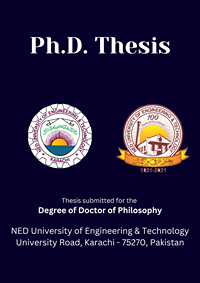Synthesis of Zno Nanostructures for Environmental and Renewable Energy Applications (PhD Thesis)
Material type: TextLanguage: English Publication details: Karachi : NED University of Engineering and Technology Department of Materials and Metallurgical Engineering, c2021Description: XVII, 75 p. : illSubject(s): DDC classification:
TextLanguage: English Publication details: Karachi : NED University of Engineering and Technology Department of Materials and Metallurgical Engineering, c2021Description: XVII, 75 p. : illSubject(s): DDC classification: - 620.115378242 SHA
| Item type | Current library | Shelving location | Call number | Status | Date due | Barcode |
|---|---|---|---|---|---|---|
 Reference Collection
Reference Collection
|
Government Document Section | Govt Publication Section | 620.115378242 SHA | Available | 97228 | |
 Reference Collection
Reference Collection
|
Government Document Section | Govt Publication Section | 620.115378242 SHA | Available | 97229 |
Abstract :
Industrial effluents are very harmful for life and need to be degraded to preserve the environment from hazardous dyes specifically from textile effluents as major contributor. Zinc oxide (ZnO) nanostructures with co-catalysts like Cu, Sn, Ag, TiO₂ and Boron have great potential to be used as photo catalyst for the removal of industrial pollutants like methyl orange, methylene blue and rhodamine B by photo catalysis under Ultra violet (UV) light. In present work nanostructures of ZnO and TiO₂ fabricated by the hydrothermal method and a thin layer of non-precious metal nanoparticles was deposited on them for fast trapping of UV and sun light. Not only the efficiency of ZnO photo catalysts was improved by the deposition of nanoparticles including Cu, Sn, TiO₂ Boron and Ag, but thin layer can trap sun light at greater extent and due to synergetic effect the photo catalytic properties of hybrid catalysts will be highly improved. This research work deals with the improvement of efficiency of ZnO nanostructures by depositing nonprecious nanoparticles for the absorption of most part of the sun light. Also the optical band gap analysis was resulted in successful reduction of band gap of ZnO by all used metallic and nonmetallic doping impurities. Therefore the produced doped nanostructures bear an excellent potential to be used for wide range of optoelectronics, nano-electronics, energy and environmental applications. Also this work has a great potential in obtaining Hydrogen from water whereby water splitting can be accelerated for foster production of hydrogen gas with hydrogen being very clean fuel with zero carbon emission in the environment is the best alternative to the fossil fuels using photo catalyst for water splitting facilitated by the solar energy. The concept of research project has lots of potential to be explored and it will be excellent step in the strengthening the renewable energy reservoirs in Pakistan.
